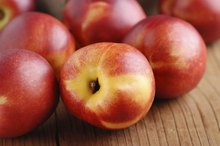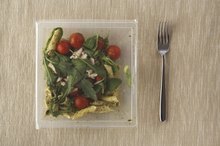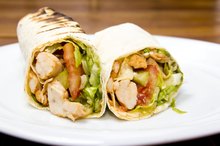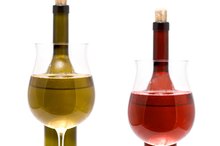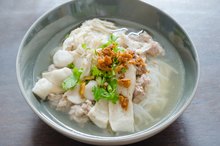What does fact checked mean?
At Healthfully, we strive to deliver objective content that is accurate and up-to-date. Our team periodically reviews articles in order to ensure content quality. The sources cited below consist of evidence from peer-reviewed journals, prominent medical organizations, academic associations, and government data.
The information contained on this site is for informational purposes only, and should not be used as a substitute for the advice of a professional health care provider. Please check with the appropriate physician regarding health questions and concerns. Although we strive to deliver accurate and up-to-date information, no guarantee to that effect is made.
Glycemic Index for Dill Pickles
The process of pickling cucumbers in a mixture of vinegar, herbs, salt and sugar results in a product commonly called pickles. The dill pickle variety, according to the New York Food Museum, is a favorite among consumers 1. Not only do dill pickles make a nutritious accompaniment in a sandwich or a salad, they also rank extremely low on the glycemic index scale.
Determination of Glycemic Index
To determine the glycemic index of a food product, human subjects must ingest the product before researchers study its effect on blood-glucose levels. Linus Pauling Institute explains that test volunteers are administered 50g of a test food on any given day, followed by 50g of a control food, which contains an equal amount of carbohydrates as the test food, on a later day 3. Blood is drawn before consumption, as well as several hours after consumption at regular intervals, to note changes in blood-glucose levels. The results are plotted as a curve and the glycemic index is calculated by dividing the area beneath the curve post-consumption of the test food by the corresponding area of the control food.
- To determine the glycemic index of a food product, human subjects must ingest the product before researchers study its effect on blood-glucose levels.
Background Information
List of Foods With Sulfites
Learn More
The glycemic index is a measure of a food product's ability to elevate blood-glucose levels. Foods with a minimal impact on blood-glucose levels have a glycemic index of 55 or less. Foods with a moderate impact on blood-glucose levels have a glycemic index of between 56 and 69. Food products with a glycemic index above 69 have a significant impact on blood-glucose levels. According to Nancy Klobassa Davidson, R.N., of Mayo Clinic, a healthy blood-glucose level in a fasting state ranges between 70 to 100mg/dL. After meals, a blood-glucose level below 180mg/dL is considered "normal." People diagnosed with diabetes or thyroid disorders should pay particular attention to the glycemic index of food products as they may potentially worsen symptoms.
- The glycemic index is a measure of a food product's ability to elevate blood-glucose levels.
- Food products with a glycemic index above 69 have a significant impact on blood-glucose levels.
Nutritional Significance
Jenny Brand-Miller, Ph.D., co-author of "The New Glucose Revolution: Complete Guide to Glycemic Index Value," reports that a dill pickle has a glycemic index of 15. The low glycemic index of dill pickles makes it an ideal food option for those diagnosed with diabetes, hypothyroidism or obesity. Furthermore, the USDA Nutrient Data Laboratory states that a 65g serving of dill pickle contains a miniscule eight calories with almost no fat content. Furthermore, dill pickles provide nutrients such as:
- vitamin A
- vitamin K
- beta-carotene
- calcium
- sodium
- Jenny Brand-Miller, Ph.D., co-author of "The New Glucose Revolution: Complete Guide to Glycemic Index Value," reports that a dill pickle has a glycemic index of 15.
- Furthermore, the USDA Nutrient Data Laboratory states that a 65g serving of dill pickle contains a miniscule eight calories with almost no fat content.
Recommendations
Nectarines and the Glycemic Index
Learn More
Although dill pickles have a low glycemic index, when added to certain meals, such as a sandwich, the glycemic index of the meal may have a significant impact on blood-glucose levels. To keep blood-glucose levels in check, pair dill pickles with other food items that rank equally low on the glycemic index scale, such as leafy vegetables.
Related Articles
References
- New York Food Museum: What is a Pickle?
- USDA National Nutrient Database: Pickles, Cucumber, Dill or Kosher Dill
- Linus Pauling Institute: Glycemic Index and Glycemic Load
- Ojo O, Ojo OO, Adebowale F, Wang XH. The effect of dietary glycaemic index on glycaemia in patients with type 2 diabetes: A systematic review and meta-analysis of randomized controlled trials. Nutrients. 2018;10(3):373. Published 2018 Mar 19. doi:10.3390/nu10030373
- Glycemic Index and Diabetes. American Diabetes Association
- Search for the Glycemic Index. The University of Sydney
- Zeevi D, Korem T, Zmora N, et al. Personalized Nutrition by Prediction of Glycemic Responses. Cell. 2015;163(5):1079-1094. doi:10.1016/j.cell.2015.11.001+
- Sacks FM, Carey VJ, Anderson CA, et al. Effects of high vs low glycemic index of dietary carbohydrate on cardiovascular disease risk factors and insulin sensitivity: the OmniCarb randomized clinical trial. JAMA. 2014;312(23):2531-41. doi:10.1001/jama.2014.16658.
- Vega-lópez S, Venn BJ, Slavin JL. Relevance of the Glycemic Index and Glycemic Load for Body Weight, Diabetes, and Cardiovascular Disease. Nutrients. 2018;10(10). doi:10.3390/nu10101361
- Glycemic Index Database. University of Sydney. Updated October 13, 2020
- Eleazu C. O. (2016). The concept of low glycemic index and glycemic load foods as panacea for type 2 diabetes mellitus; prospects, challenges and solutions. African health sciences, 16(2), 468–479. doi:10.4314/ahs.v16i2.15
- Foster-Powell, Kaye, Holt, Susanna and Brand-Miller, Janette. "International table of glycemic index and glycemic load values: 2002." American Journal of Clinical Nutrition. 76,:1: 5-56 (2002).
- International Carbohydrate Quality Consortium, Jenkins, D. J., Willett, W. C., Astrup, A., Augustin, L. S., Baer-Sinnott, S., … Wolever, T. M. (2014). Glycaemic index: did Health Canada get it wrong? Position from the International Carbohydrate Quality Consortium (ICQC). The British journal of nutrition, 111(2), 380–382. doi:10.1017/S0007114513003905
- Leroux, MarcusFoster-Powell, Kaye, Holt, Susanna and Brand-Miller, Janette. "International Table of Glycemic Index and Glycemic Load Values: 2002." American Journal of Clinical Nutrition. Vol. 76, No. 1, 5-56, (2002).
- Lui, S., Willett, WC, et al. "A prospective study of dietary glycemic load, carbohydrate intake, and risk of coronary heart disease in US women.." American Journal of Clinical Nutrition. 71(6):1455-61. (2001).
- Mayer-Davis, E.J., Dhawan, A et al. "Towards understanding of glycaemic index and glycaemic load in habitual diet: associations with measures of glycaemia in the Insulin Resistance Atherosclerosis Study.." British Nutrition Journal. 95(2):397-405. (2006).
- Sacks, F. M., Carey, V. J., Anderson, C. A., Miller, E. R., 3rd, Copeland, T., Charleston, J., … Appel, L. J. (2014). Effects of high vs low glycemic index of dietary carbohydrate on cardiovascular disease risk factors and insulin sensitivity: the OmniCarb randomized clinical trial. JAMA, 312(23), 2531–2541. doi:10.1001/jama.2014.16658
- Salmeron, J, Manson, JE, et al. "Dietary fiber, glycemic load, and risk of non-insulin-dependent diabetes mellitus in women.." Journal of the American Medical Association. 12;277(6):472-7. (1997).
- Vega-López, S., Venn, B., & Slavin, J. (2018). Relevance of the Glycemic Index and Glycemic Load for Body Weight, Diabetes, and Cardiovascular Disease. Nutrients, 10(10), 1361. doi:10.3390/nu10101361
- Zeevi, D. Korem N. et al. Personalized Nutrition by Prediction of Glycemic ResponsesCell. 163:(5):1079-94. November 2015.
Writer Bio
Stephanie Lee began writing in 2000 with concentration on food, travel, fashion and real estate. She has written for Amnesty International and maintains three blogs. Lee holds a Bachelor of Arts in international relations from the University of California, Irvine, and an M.B.A. from Concordia University.

